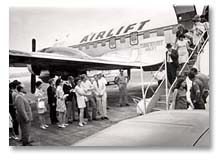 Cuban Airlift to the United States
Cuban Airlift to the United States
The most dramatic migration to impact Miami came right after the Cuban
Revolution of 1959. After Fidel Castro seized power, thousands of Cuban migrants
poured into Miami as exiles (between 1959 and 1962, an estimated 248,070 Cubans
migrated to the U.S., with over half settling in Miami). Most believed that
Castro’s victory would be short-lived and they would return to Cuba. Yet
Castro’s enduring power, and his transformation of the island into a Communist
state, forced many exiles to remain in Miami indefinitely.
The United States government welcomed the exiles and established
programs designed to help ease their transition to life in the United States.
The Cuban Refugee Emergency Center in the former Miami News building (later
renamed the Freedom Tower) processed the migrants and coordinated volunteer
relief efforts.
In 1961, President John F. Kennedy established the Cuban Refugee
Program, with the government providing funds for resettlement, health care, job
training, and direct relief. That same year, the government worked with the Catholic Church
on a program, dubbed Operation Pedro Pan, to get children out of Cuba. This
clandestine operation ultimately brought over 14,000 children from Cuba to
Miami. Close to 400,000 additional Cuban migrants came to the U.S. as part of
the Cuban Refugee Airlift, resulting from a 1965 deal struck between President
Lyndon Johnson and Castro to airlift those Cuban who had relatives in the U.S.
and wished to leave.
Again in April of 1980, Castro granted
those wishing to leave the island permission to do so, from the port of Mariel.
The influx of Cubans into Miami since 1959 has had profound effects on all
aspects of local life, and has transformed Miami into a truly bi-lingual and
bi-cultural city.
|
|



